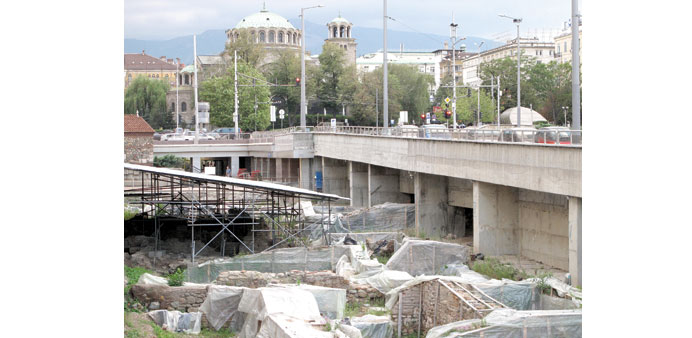TRACES OF THE ROMAN EMPIRE: Plastic foil covers the remains of Roman-era walls, while a raised concrete road skirts the rich remains of Serdika, a Roman city in the soil under modern Sofia, Bulgaria. In the background: Sveta Nedelya, a major Orthodox Christian church.
By Elena Lalova
It is a sad prospect: the ruins of ancient Roman mansions and bath-houses are overgrown in thick weeds, while slimy ponds have formed in the hollows left by archaeological excavations.
This site in today’s Bulgaria was a city block that exuded wealth in Roman times. Today it exudes neglect. During the rainy summer of 2014, the authorities took no action to pump the water and mud out. There is no archaeologist anywhere to be seen.
“That’s an eco-reservation,” jokes a teenager passing by the excavation.
It’s not as if it were some archaeological site in a remote region, such as the Rhodopes mountains of eastern Bulgaria. In fact, the erstwhile Roman city of Serdika lies in the heart of the capital Sofia.
“Serdika is my Rome,” was the remark of Roman emperor Constantine the Great, who ruled from 306 to 337, about his favourite city.
Constantine only left Serdika when he decided to make the city named after him, Constantinople — today’s Istanbul — into the capital of Byzantium, the Eastern Roman Empire.
The poorest European Union country, Bulgaria possesses a rich ancient heritage. Roman villas and amphitheatres, Thracian burial sites, and the even older hilltop town of Perperikon are among its attractions.
Bulgarian experts say that in Europe, only Italy and Greece have more ancient attractions to offer.
But this heritage is being neglected, as shown by the case of Serdika. Disputes, a lack of money and well organised artefact robbers are all obstructing the work of the archaeologists in this Balkan country.
The miserable state of the unprotected site, which is located close to the Serdika subway stop in Sofia, angers even the average citizen.
The sorry situation has only been compounded by the fact that two state-sponsored tenders to conserve the site have fallen through. Now a dispute over a third tender is being thrashed out in court, Culture Minister Martin Ivanov says.
As a result, nobody feels responsible for the site, and there is no money for an interim solution.
Just as was the case in other southern European cities, construction of a subway in Sofia between 2010 and 2012 turned up many traces of the Roman era in the subsoil. Many remarkable parts of these ancient buildings have been integrated into the Serdika subway station.
Back in Roman times, there were luxury villas here with sewerage and water supply lines and paved streets.
But some of the newly discovered ruins are outside the subway station precincts. Unless a small miracle happens, those excavations will for a third winter in a row be exposed to the assault of wind, rain and ice.
“There is a risk that this winter we are going to lose a large part of the archaeological find,” deputy mayor Todor Tchobanov — himself a trained archaeologist — warns.
The neglected finds are part of the large-scale “Ancient Complex of Serdika” project set up by the city of Sofia. The Bulgarian taxpayer has already provided 3 million euros (3.8 million dollars) for it, while the EU is supporting it with a further 8 million euros.
With the help of this project, optimistic officials still hope Sofia, home to 1.5 million people, can become the European Capital of Culture in five years’ time. —DPA

